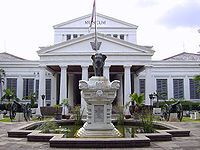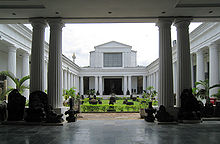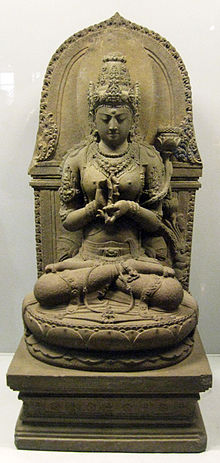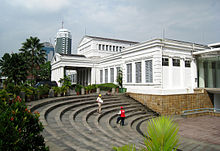- National Museum of Indonesia
-
National Museum
Museum Nasional
Front view of the museum.Established 1778 Location Jl. Medan Merdeka Barat, Jakarta Pusat, Jakarta, Indonesia Type Archaeology museums Website Museum Nasional Indonesia The National Museum of Indonesia (Indonesian: Museum Nasional), is an archeological, historical, ethnological, and geographical museum located in Jakarta. Popularly known as Elephant Building (Indonesian: Gedung Gajah) after the elephant statue in its forecourt. Its broad and fascinating collections covers all of Indonesia's territory and almost all of its history. The museum has endeavoured to preserve Indonesia's heritage for two centuries.[1]
Contents
History
On April 24, 1778, a group of Dutch intellectuals established a scientific institution under the name Bataviaasch Genootschap van Kunsten en Wetenschappen, (Royal Batavian Society of Arts and Sciences).[2] This private body had the aim of promoting research in the field of arts and sciences, especially in history, archaeology, ethnography and physics, and publish the various findings.
One of the founders – JCM Radermacher – donated a building and a collection of cultural objects and books, which were of great value to start off a museum and library for the society.[3] Due to the growing collections, General Sir Thomas Stamford Raffles built a new premises on Jalan Majapahit No. 3 at the beginning of the 19th century and named it the Literary Society. In the 1862 the Dutch East Indies government decided to build a new museum that would not only serve as an office but also could be used to house, preserve and display the collections.
The Museum was officially opened in 1868 and popularly known as Gedung Gajah (Elephant Building) or sometimes called Gedung Arca (The house of Statues). It was called Gedung Gajah on account of the bronze elephant statue in the front yard – a gift to Batavia from King Chulalongkorn of Siam in 1871. It was also called Gedung Arca because a great variety of statues from different periods are on display in the house.
 The atrium (inner courtyard) of the National Museum, features Doric order Greek architecture.
The atrium (inner courtyard) of the National Museum, features Doric order Greek architecture.
In 1931, the museum's collections were shown in a world cultural exhibition in Paris. Unfortunately, a fire in the exhibition hall demolished the Dutch East Indies' exhibition pavilion and destroyed most of the objects. The museum received some insurance money as compensation and the following year these funds were used to build the old ceramics room, the bronze room, and both treasure rooms on the second floor.
On February 29, 1950 the institution became the Lembaga Kebudayaan Indonesia (Indonesian Culture Council). On September 17, 1962 it was handed over to the Indonesian government and became known as Museum Pusat (Central Museum). By decree of the Minister of Education and Culture No. 092/0/1979 May 28, 1979 it was renamed the Museum Nasional.
In 2007, a new building to the north side of existing building was opened, featuring many artifacts from prehistoric times to modern times. This new building, called Gedung Arca (Statue Building), provides a new exhibition wing. The old building is named as Gedung Gajah (Elephant Building).
Collections
 A large statue of Adityavarman as Bhairava among the museum's rich collections of Hindu-Buddhist artifacts of ancient Indonesia.
A large statue of Adityavarman as Bhairava among the museum's rich collections of Hindu-Buddhist artifacts of ancient Indonesia.
The museum has a collection of 61,600 prehistoric and anthropological artifacts, and 5,000 archeological artifacts from all over Indonesia and Asia. The museum collections is among the richest, the most complete, and the best of its kind in Indonesia and one of the finest in Southeast Asia.[4]
Gedung Gajah (Old Wing)
The museum collections is grouped and arranged according the certain subjects:
Stone Sculpture Collection (Hindu-Buddhist Art of Ancient Indonesia)
The National Museum of Indonesia has the richest and the largest collection of Hindu-Buddhist art of ancient Indonesia. The Hindu-Buddhist sculptures, relics and inscriptions was collected from Java, Bali, Sumatra, and Borneo, all are in display in the lobby, the central hall and the central atrium of the museum. The centerpiece collection also the largest artifact of the museum is the statue of Adityavarman depicted as Bhairava. This statue is more than 4 meters tall and discovered from Rambahan, Padangroco, West Sumatra.
Treasure Rooms (Archaeology and Ethnography Collection)
The Second floor of the museum is feature treasures, gold, and precious artifact and arranged in two rooms; archaeological treasure and ethnology treasure. Taking picture is prohibited in the treasure rooms.
Archaeological treasure room features ancient gold and precious relics acquired from archaeological findings, mostly originated from ancient Java. One of the most prized collection of the museum is the statue of Prajnaparamita. Dubbed as the most beautiful sculpture of ancient Java, the goddess of transcendental wisdom is displayed in the entrance of archaeology treasure room to shows about how gold jewelries and precious ornaments were worn on the body. Such ancient gold adornments were in display; such as crown, ear adornment, earrings, rings, bracelets, kelat bahu (arm bracelet), leg bracelet, waist band, belt, upawita or tali kasta (golden chain worn across the chest), and other precious artifacts of ancient Java, such as the famous Wonoboyo hoard. Wonoboyo hoard is the treasures originated from 9th century Hindu Mataram Kingdom discovered in Wonoboyo, Klaten, Central Java, near Prambanan. The treasures are golden bowl with scene of Ramayana, purse, water dipper, umbrella finial, and spoon or ladle, all were made of gold. Also discovered ancient Java gold coins with shape similar to a corn seed. Golden Hindu-Buddhist relics were also in display, such as the Hindu gods images made from gold leaf, bronze statue of Shiva Mahadeva with gold applied on his lips and third eye, the bronze statue of Avalokiteshvara and also the silver statue of youthful Manjusri.
The ethnology treasure room features treasures acquired from royal houses of Indonesia, such as regalias from various istanas, kratons and puri of Indonesian archipelago, arranged in several island zones: Sumatra, Java, Bali, Borneo, Sulawesi, and Eastern Indonesia (Nusa Tenggara, Maluku and Papua). The ethnology treasure room display various royal precious objects such as golden jewelries and weapons. The jewelries are bracelets and rings embedded with rubies, diamond, precious and semi precious stones. The collections are gilded Balinese kris weapon embedded with precious and semi precious stones and various spear heads. Golden royal crowns, gilded throne, golden royal regalia, golden tobacco container, Pekinangan (silver betel-nut set), sword and golden shield is among the collection of the treasure room.
Ceramics collection
The collection of ceramics room is ranged from Majapahit terracota to the ceramics of China, Japan, Vietnam, Thailand, and Myanmar. The museum houses a large and complete collection of ancient Chinese ceramics. It has one of the best and the most complete collections of Chinese ceramics discovered outside China. The ceramics dated from Han, Tang, Sung, Yuan, Ming, and Qing dynasty is displayed in the museum.[5] This particular collection give a good insight into Indonesia's maritime trade over the centuries. Research indicates that the Chinese sailed to India via Indonesia as early as Western Han period (205 BC to 220 AD) and that firm trade relations were subsequently established.[6]
Ethnography collection
The ethnography collection comprises a wide variety of objects that are part of Indonesian daily life as well as exhibits that are used in ceremonies and rituals. The collections is arranged according to geographic locations of each regions and islands within Indonesian archipelago: from Sumatra, Java, Kalimantan, Bali, Lesser Sunda Islands (Nusa Tenggara), to Sulawesi, Maluku, and Papua.
Examples of ancient cultures include Nias and Batak in Sumatra, the Badui in Java, Balinese, the Dayak of Kalimantan, the Toraja in Sulawesi, and the Asmat and Dani in Papua. The lifestyles of these people remained unchanged for centuries and followed same patterns as that of their ancestors. They still use some traditional laws (adat) to determine their daily activities and ceremonies.[7]
Prehistory collection
 A diorama depicting the life size model of stone equipped hunter, a Homo erectus family living in Sangiran about 900,000 years ago.
A diorama depicting the life size model of stone equipped hunter, a Homo erectus family living in Sangiran about 900,000 years ago.
The museum stores some stone age artifacts such as fossiled skull and skeleton of Homo erectus, Homo floresiensis and Homo sapiens, stone tools, menhir, stone axe, bronze ceremonial axe and Nekara (bronze drum), also ancient weapons from Indonesia.
Historical Relics Collection (Colonial Era Collection)
The front room of the museum features old relics of colonial Indonesia, from the era of Dutch East Indies Company (VOC) to Dutch East Indies. Most of the collections are antique colonial furnitures. However most of the collections has been moved to Jakarta History Museum that mostly features the history of Jakarta especially the colonial history of Batavia (old Jakarta).
Other Collections
- Bronze Collection
- Textile Collection
- Numismatics Collection
Gedung Arca (New Wing)
Unlike the exhibition layout of the older building, the museum's permanent exhibit in the new building is based on the frameworks of cultural elements, which Prof. Koentjaraningrat classified into seven substances of culture:[8]
- Religious system and religious ceremony
- Societal systems and organization
- Knowledge systems
- Language
- Arts
- Livelihood systems
- Technology and tool systems
Today National Museum has completed the new north wing which consist of a basement and seven levels (floors), four of which host permanent exhibitions, while other levels is functioned as the Museum's office. The layout of the four levels is as follows:[9]
- Level 1: Man and Environment
- Level 2: Knowledge, Technology and Economy
- Level 3: Social Organization and Settlement Patterns
- Level 4: Treasures and Ceramics
These old building and the new wing is connected via the old ethnography room through a glass walled bridge gallery. The bridge gallery is located over the outdoor amphitheatre. The temporary exhibitions with certain themes often took place in this connecting gallery. The Gedung Arca also houses two temporary exhibition halls, one in the ground floor and another is in the basement floor. The basement floor also host the ASEAN room that feature photos exhibition and modest artifacts from 10 ASEAN countries. Cafetaria and souvenir stall is located in the ground floor.
References
- ^ Rosi, Adele (1998). Museum Nasional Guide Book. Jakarta: PT Indo Multi Media,Museum Nasional and Indonesian Heritage Society. pp. 2.
- ^ Rosi, Adele (1998). Museum Nasional Guide Book. Jakarta: PT Indo Multi Media,Museum Nasional and Indonesian Heritage Society. pp. 4.
- ^ http://masterpieces.asemus.museum/stories.aspx?id=d7b4fe1a-4fa6-49c5-aa74-b880aada6ad1 VCM – Shared Cultural Heritage
- ^ "Lonely Planet review on Museum Nasional". http://www.lonelyplanet.com/indonesia/jakarta/sights/406074.
- ^ "Museum in Jakarta". http://www.jakarta.go.id/en/jakartaku/museum_di_dki04.htm.
- ^ Rosi, Adele (1998). Museum Nasional Guide Book. Jakarta: PT Indo Multi Media,Museum Nasional and Indonesian Heritage Society. pp. 54.
- ^ Rosi, Adele (1998). Museum Nasional Guide Book. Jakarta: PT Indo Multi Media,Museum Nasional and Indonesian Heritage Society. pp. 18.
- ^ Sri Handari, Dedah Rufaedah (2007). Katalog "Gedung Arca" Museum Nasional. Jakarta: Museum Nasional. pp. 2.
- ^ Sri Handari, Dedah Rufaedah (2007). Katalog "Gedung Arca" Museum Nasional. Jakarta: Museum Nasional. pp. 2.
Literature
- Lenzi, Iola (2004). Museums of Southeast Asia. Singapore: Archipelago Press. pp. 200. ISBN 981-4068-96-9.
External links
Coordinates: 6°10′34″S 106°49′18″E / 6.17611°S 106.82167°E
Categories:- 1778 establishments
- Museums in Java
- Buildings and structures in Jakarta
- National museums
- National museums by country
- Museums established in 1778
Wikimedia Foundation. 2010.





